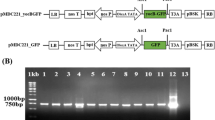Abstract
Transposon mutagenesis was used to locate the genes for phaseolotoxin biosynthesis inPseudomonas syringae pathovar.phaseolicola. Mutants unable to produce toxin were obtained that carried Tn5 on different chromosomal restriction fragments. None of the Tn5-induced nontoxigenic mutants carried the transposon in plasmid DNA. The insertion of Tn5 intotox DNA was confirmed by site-directed mutagenesis. The results reported here suggest the involvement of at least five chromosomal genes in phaseolotoxin biosynthesis. All of the toxinminus mutants retained both full pathogenicity on beans and resistance to the toxin.
Similar content being viewed by others
Literature Cited
Bergquist PL, Adelberg AE (1972) Abnormal excision and transfer of chromosomal segments by a strain ofEscherichia coli K-12. J Bacteriol 111:119–128
Bergquist PL, Lane HED, Malcolm L, Downard RA (1982) Molecular homology and incompatibility in the IncF1 plasmid group. J Gen Microbiol 128:223–238
Curiale MS, Mills D (1982) Integration and partial excision of a cryptic plasmid inPseudomonas syringae p.v.phaseolicola. J Bacteriol 152:797–802
Currier TC, Nester EW (1976) Isolation of covalently closed circular DNA of high molecular weight from bacteria. Anal Biochem 76:431–441
Currier TC, Morgan TK (1983) Plasmids ofPseudomonas syringae: no evidence of a role in toxin production or pathogenicity. Can J Microbiol 29:84–89
Eckhardt T (1978) A rapid method for the identification of plasmid deoxyribonucleic acid in bacteria. Plasmid 1:584–588
Davis RW, Simon M, Davidson N (1971) Electron microscope heteroduplex methods for mapping regions of base sequence homology in nucleic acids. Methods Enzymol 21:413–428
Ferguson AR, Johnston JS, Mitchell RE (1980) Resistance ofPseudomonas syringae p.v.phaseolicola to its own toxin, phaseolotoxin. FEMS Microbiol Lett 7:123–125
Gantotti BV, Patil SS, Mandel M (1979) Apparent involvement of a plasmid in phaseolotoxin production byPseudomonas phaseolicola. Appl Environ Microbiol 37:511–516
Hoitink HAJ, Pelletier RL, Coulson JG (1966) Toxemia of halo blight of beans. Phytopathology 56:1062–1065
Jamieson AF, Bieleski RL, Mitchell RE (1981) Plasmids and phaseolotoxin production inPseudomonas syringae p.v.phaseolicola. J Gen Microbiol 122:161–165
Jorgenson RA, Rothstein SJ, Reznikoff WS (1979) A restriction enzyme cleavage map of Tn5 and location of a region encoding neomycin resistance. Mol Gen Genet 177:65–72
Kado CI, Liu S-T (1981) Rapid procedure for detection and isolation of large and small plasmids. J Bacteriol 145:1265–1373
Karn J, Brenner S, Barnett L, Cesareni G (1980) Novel bacteriophage λ cloning vector. Proc Natl Acad Sci USA 77:5172–5176
Legrain C, Stalon V, Glansdorff N, Gigot D, Pierard A, Crabeel M (1976) Structural and regulatory mutation allowing utilization of citrulline or carbamoylaspartate as a source of carbamoylphosphate inEscherichia coli K-12. J Bacteriol 128:39–48
Maniatis T, Fritsch EF, Sambrook J (1982) Molecular cloning: a laboratory manual. Cold Spring Harbor NY: Cold Spring Harbor Laboratory
Marmur J (1963) A procedure for the isolation of deoxyribonucleic acid from microorganisms. Methods Enzymol 6:726–738
Mitchell RE (1976) Isolation and structure of a chlorosis-inducing toxin ofPseudomonas phaseolicola. Phytochemistry 15:1941–1947
Mitchell RE (1978) Halo blight of beans: toxin production by severalPseudomonas phaseolicola isolates. Physiol Plant Pathol 13:37–49
Mitchell RE (1979) Bean halo blight: comparison of phaseolotoxin and N-phosphoglutamine. Physiol Plant Pathol 14:119–128
Panapoulos NJ, Staskawicz BJ, Sandlin D (1979) Search for plasmid-associated traits and for a cloning vector inPseudomonas phaseolicola. In: Timmis KN, Puhler A (eds) Plasmids of medical, environmental and commercial importance. Amsterdam: Elsevier/North-Holland, pp 365–372
Quigley NB, Love D, Kay S, Bergquist PL, Lane D (1985) Basis of phaseolotoxin tolerance inPseudomonas syringae p.v.phaseolicola. (In preparation)
Rigby PWJ, Dieckmann M, Rhodes C, Berg P (1977) Labeling deoxyribonucleic acid to high specific activity in vitro by nick translation with DNA polymerase I. J Mol Biol 113:237–251
Rosenberg D, Case-Delbart F, Dusha I, David M, Boucher C (1982) Megaplasmids in plant-associated bacteriaRhizobium meliloti andPseudomonas solanacearum. J Bacteriol 150:402–406
Scott DB, Ronson CW (1982) Identification and mobilization by cointegrate formation of a nodulation plasmid inRhizobium trifolii. J Bacteriol 151:36–43
Simon R, Priefer U, Pühler A (1983) A broad host range mobilization system for in vivo genetic engineering: transposon mutagenesis in gram negative bacteria. Biotechnology 1:784–791
Smidt ML, Vidaver AK (1982) Bacteriocin production byPseudomonas syringae PsW-1 in plant tissue. Can J Microbiol 28:600–604
Staskawicz BJ, Panopoulos NJ (1980)Phaseolotoxin transport inEscherichia coli andSalmonella typhimurium via the oligo-peptide permease. J Bacteriol 142:474–479
Staskawicz BJ, Panopoulos NJ, Hoogenraad NJ (1980) Phaseolotoxin-insensitive ornithine carbamoyltransferase ofPseudomonas syringae p.v.phaseolicola: basis for immunity tophaseolotoxin. J Bacteriol 142:720–723
Vidaver AK (1976) Prospects for control of phytopathogenic bacteria by bacteriophages and bacteriocins. Annu Rev Phytopathol 14:451–465
Wahl GM, Stern M, Stark GR (1979) Efficient transfer of large DNA fragments from agarose gels to diazobenzyloxymethyl-paper and rapid hybridization using dextran sulfate. Proc Natl Acad Sci USA 76:3683–3687
Author information
Authors and Affiliations
Rights and permissions
About this article
Cite this article
Quigley, N.B., Lane, D. & Bergquist, P.L. Genes for phaseolotoxin synthesis are located on the chromosome ofPseudomonas syringae pv.phaseolicola . Current Microbiology 12, 295–299 (1985). https://doi.org/10.1007/BF01567981
Issue Date:
DOI: https://doi.org/10.1007/BF01567981




